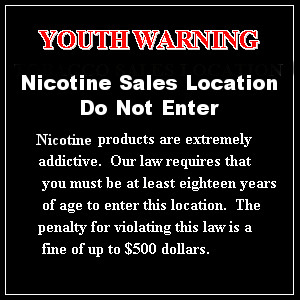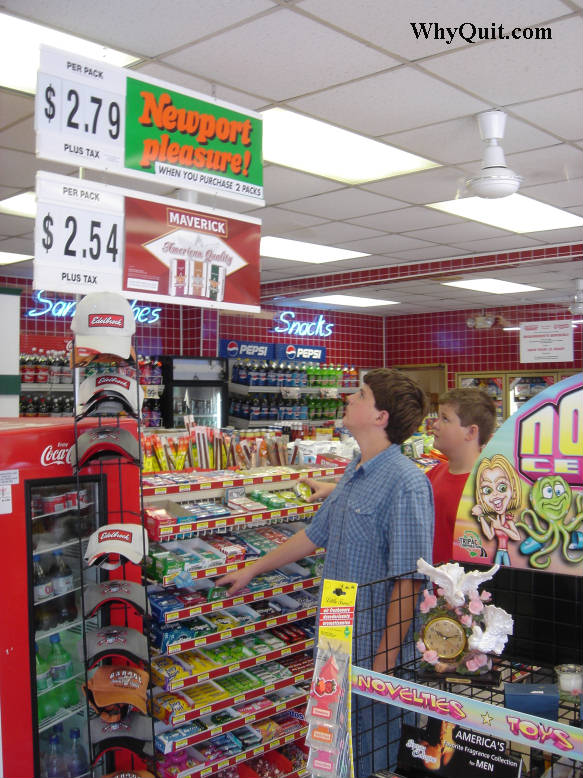An ordinance forcing merchants to select between selling the highly addictive chemical nicotine or having children and teenagers as customers

WHEREAS, schools and social media are reporting widespread e-cigarette vaping and use of JUULs by students in schools, including in classrooms and bathrooms;
WHEREAS, a 2019 JAMA study found that among 12 to 15 year-olds who had used e-cigarettes that, within 2 years, they were 3 times more likely to become smokers;
WHEREAS, chemical dependency upon smoking nicotine has long been our [city's, county's, or state's] leading cause of preventable death;
WHEREAS, the U.S. Surgeon General has determined that nicotine is as addictive as heroin or cocaine;
WHEREAS, the Director of the National Institute on Drug Abuse has determined that nicotine dependence is a mental illness, a brain wanting disorder in which dopamine pathways compromised by nicotine have assigned nicotine use the same priority as eating food;
WHEREAS, each day nearly 4,000 young people between the ages of 12 and 17 smoke their first cigarette, with 1,000 becoming daily smokers;
WHEREAS, a 2005 study found that 87% of students who smoked daily were chemically dependent as measured by standards in the Diagnostic and Statistical Manual for Mental Disorders, 4th edition (DSM-IV);
WHEREAS, 72% of surveyed smokers in a July 2013 Gallup Poll openly declared that they are addicted to smoking cigarettes;
WHEREAS, a significant percentage of youth begin exhibiting signs of loss of autonomy over continued smoking after smoking their first few cigarettes;
WHEREAS, a September 2013 study found that 93% of smokers who used e-cigarettes to attempt to quit smoking were unable to stop smoking for 6 months, as compared to 94% who failed to quit while using the nicotine patch;
WHEREAS, e-cigarettes are now being actively marketed in nearly all neighborhood stores;
WHEREAS, the Centers for Disease Control reported on September 6, 2013 that during 2011-12 e-cigarette ever use among all students in grades 6-12 doubled from 3.3 percent to 6.8 percent, with 76.3 percent of current e-cigarette users also reporting current smoking of conventional cigarettes;
WHEREAS, the National Institute on Drug Abuse has found smokeless tobacco to be addictive, that the amount of nicotine absorbed is three times higher than from cigarettes, that chewing tobacco and snuff contain 28 carcinogens, and that 39% of smokeless tobacco users have smoked within the past month;
WHEREAS, the Centers for Disease Control has determined that smoking and smokeless tobacco use are initiated and established primarily during adolescence, with 88% of adult daily smokers having started smoking by the age of 18 years;
WHEREAS, a July 31, 2013 Gallup Poll found, as have other real-world assessments, that replacement nicotine products are generally ineffective in population level quitting, with only a tiny fraction of successful quitters crediting them for their success (about 8 percent);
WHEREAS, addiction to replacement nicotine products is being reported among never users of tobacco;
WHEREAS, on April 2, 2013, the FDA approved replacement nicotine for use while continuing to smoke cigarettes, thus encouraging its use as an aid to supplement and support continued smoking in situations where smoking isn't permitted;
WHEREAS, in 2000 the Canadian government started requiring cigarette pack addiction warning labels, which then read: "Warning Cigarettes Are Highly Addictive - Studies have shown that tobacco can be harder to quit than heroin or cocaine";
WHEREAS, although proposed, there currently is no U.S. addiction warnings required on any nicotine product, and we could locate no merchant selling nicotine products who has voluntarily posted warning signs teaching and alerting adolescent customers that the nicotine products being actively marketed by the store are highly addictive;
WHEREAS, instead, we see store marketing enticing and inviting our children to "come to where the flavor is," to taste great menthol, to experience pleasure, or to give fruit flavored e-cigarettes or cinnamon surge nicotine gum a try;
WHEREAS, we also note that the Surgeon General contends that teens who smoke nicotine are three times more likely than nonsmokers to use alcohol, eight times more likely to use marijuana, and 22 times more likely to use cocaine;
WHEREAS, aside from smoked nicotine being a gateway to illegal drugs, we are likewise concerned with novel e-cigarettes touted as being "safer" becoming a gateway to cigarette smoking, and undoing decades of youth nicotine dependency prevention efforts;
WHEREAS, the World Health Organization predicts that if current trends continue, 250 million children and teenagers alive today who continue smoking into adulthood will die from tobacco-related diseases.
WHEREAS, if heroin or cocaine were a legal product, we certainly would not allow them to be sold and marketed in the presence of children and teenagers;
AND WHEREAS, it is reasonable, rational and responsible to require merchants wishing to sell what may be earth's most captivating chemical to elect between the marketing and sale of nicotine products, and having children and teenagers as customers;
NOW THEREFORE, we find it necessary to erect a physical barrier between those marketing, selling and profiting from chemical dependency upon nicotine, and the immature, developing and vulnerable minds of children and teens currently being subjected to those marketing and sales pressures. We also seek to use the engines of government to warn youth of the extremely addictive nature of nicotine products. It is the objective of this [statute/ordinance] to substantially diminish tobacco use pressures which daily bombard our young.
Section I.
Nicotine Product Sales Locations
A. Nicotine products may not be sold or distributed at any business location allowing access to persons under eighteen years of age. Section I shall take effect one year from date of enactment.
1. Nicotine products may only be sold or distributed indoors at permanent fixed business locations. All retail nicotine product sales locations must have a door to control youth access.
2. Each entrance to any nicotine product sales location shall conspicuously display a legible sign having a minimum size of 8 inches by 8 inches (8" x 8"). The sign shall read, "YOUTH WARNING - Nicotine Sales Location - Do Not Enter - Nicotine products are extremely addictive. Our law requires that you must be at least 18 years of age to enter this location. The penalty for violating this law is a fine of up to $500 dollars."
B. Any nicotine product sales location violating any provision of this section shall be fined not less than $100 nor more than $1,000 for a first violation, and not less than $500 nor more than $5,000 for any subsequent violation. The business license of any location found to have committed a flagrant or repeat violation shall be suspended for a minimum of one year but not more than five years.
C. All law enforcement, fire, zoning, public health officials, school principles and assistant principles, school nurses, and school guidance counselors are granted jurisdiction and authority to investigate, enforce and prosecute violations under this section. Fifty percent of any fine recovered under this section shall be awarded to, or divided among, the investigating, enforcing and prosecuting authorities, with all such awards being used to expand enforcement of this section, or enforcement of any other state or local law intended to prevent youth nicotine or tobacco use.
D. Any person under the age of eighteen years who enters a nicotine product sales location may be fined up to $500. The Court may suspend any fine subject to attendance and proof of successful completion of a nicotine dependency prevention or cessation program.
Section II.
All Government Agencies/Departments to Assist in Denormalization
A. Nicotine dependency denormalization is the process of creating widespread community awareness that the primary reason that almost all adult daily tobacco users use tobacco is not for flavor, taste, to make new friends, to rebel, for pleasure, because of boredom, to look more adult, or for adventure. It is because nicotine has desensitized their brain, they are now chemically dependent upon it, and will likely experience physical withdrawal if they attempt to quit. It is the process of using truth to protect young minds from becoming lifelong slaves to nicotine.
B. All government agencies and departments shall assist, when and where practical, cost effective and convenient, in helping denormalize nicotine dependency within the [city, county, state].
C. Without limitation, all agencies and departments are expressly authorized to use and convey any subject matter contained in the introduction to this [ordinance/statute] as part of any nicotine dependency denormalization campaign.
D. All agencies are expressly authorized to use [city, county, state] lands, buildings and vehicles to help convey their nicotine dependency denormalization message.
E. All public school libraries and public libraries shall remove all nicotine product advertising from all magazines prior to making them available for reading, or make arrangements with publishers to use existing selective binding technology to receive magazines free of nicotine industry image or product marketing.
F. Fire, police and health departments are authorized to conduct nicotine dependency prevention and/or cessation programs, and to apply for grants and accept donations to fund such programs.

Share this Proposed Law with Your Leaders & Community
The objective of the above draft ordinance/statute is simple. To erect a physical barrier between the adolescent mind, and shotgun nicotine product marketing and sales that has zero regard for the age of the person it strikes. It also empowers local government in becoming active in teaching community youth the truth as to why nearly all daily smokers smoke.
If we can require hard liquor to be sold in stand-alone liquor stores then why not a substance that is up to nine times as addictive to the human population?
Consider e-mailing a copy of this proposed ordinance to your city or county council members. You should be able to quickly locate their e-mail addresses using Google. Suggest it as a proposed bill to your state legislative representatives or write a short letter to the editor suggesting that it's time to remove tobacco products from neighborhood candy stores. Any input on the above draft ordinance/statute would be greatly appreciated. Please forward comments, suggestions and criticisms to john@whyquit.com.
John R. Polito
Director WhyQuit.com


